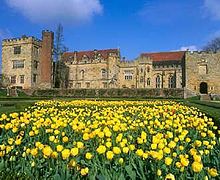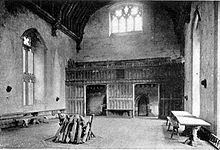Penshurst Place
Penshurst Place is a manor house near Tonbridge in the English county of Kent , southeast of London . The Sidney family used to live there and the great Elizabethan poet, courtier and soldier Sir Philip Sidney was born here. The original medieval house is one of the most complete examples of 14th century home decor in England that has survived to this day. Parts of the house and the gardens are open to the public.
history
The former village of Penshurst was within the manor of that name; the manorial system appears in the scriptures sometimes as Penecestre and now as Penchester , a name adopted by Stephen de Pencestre , Lord Warden of the Cinque Ports , who held the manor towards the end of the 13th century.
The present mansion was built in 1341 for Sir John de Pulteney , a London merchant and four-time Lord Mayor of London , who wanted a country estate within easy reach of London by horse. At that time, such houses were no longer castles: they were more like residential buildings that could be defended in an emergency. When the third son of King Henry IV , John of Lancaster, 1st Duke of Bedford , lived in Penshurst Place, the second such mansion, called the Buckingham Building , was built. It was named after its future owners, the Dukes of Buckingham . Edward Stafford, 3rd Duke of Buckingham , was executed at the behest of King Henry VIII in 1521 after a lavish feast in Penshurst Place which the Duke held in honor of King Henry VIII . The mansion then remained in the hands of the Crown for the remainder of Henry's reign. Heinrich used it as a hunting lodge, which he visited with his courtier Brandon . The property is only a few miles from Hever Castle , where Heinrich's second wife, Anne Boleyn , grew up.
In 1550 Henry's son, King Edward VI. , Fiefdom of Sir Ralph Fane , a supporter of Protector Somerset , mansion and estate , but was revoked two years later after Sir Ralph was executed for treason .
The Sidney family
Penshurst Place was expanded in 1552 when Edward VI. the house of Sir William Sidney (1482–1554), who was the courtier of Edward's father, Henry VIII, was a fief. Sir Williams' son Henry (1529–1586) married Lady Mary Dudley , whose family became involved in the affair of Lady Jane Gray , although Henry himself escaped such entanglements. He had additional living quarters and the King's Tower added to Penshurst Place and gardens that are now among England's oldest private gardens. The records of this go back to the year 1346.
Philip Sidney (1554–1586), Henry's son, was born in 1554 in Penshurst Place. The poet and courtier was buried in the Old Paul Church in London; he had died 25 days after a gunshot wound inflicted on him in the Battle of Zutphen , but his grave was destroyed in the Great Fire of London in 1666 .
Then Philips' brother Robert inherited Penshurst Place. In his time he had more showrooms added to the house, e.g. B. an impressive "long gallery". He had also inherited the Earldom of Leicester . His descendants lived in the mansion for seven generations. Penshurst Place fell into disrepair by the 19th century, but its new residents in 1818, Sir John Shelley-Sidney and his son Philip , began a restoration. The latter was appointed first Baron de L'Isle and Dudley in 1835 . The 6th Baron, William Sidney (1909-1991) was one of only two people to receive both the Victoria Cross and the Order of the Garter. He was made 1st Viscount De L'Isle in 1956. It is thanks to him and his son, the 2nd Viscount, that most of the modern restoration of Penshurst Place is done, although the house was very neglected during World War I. Today part of the house and the gardens are open to the public.
Equipment of the manor house
In the house you can find evidence of its use over its 670 years of history:
- The showrooms filled with collections that generations of the Sidney family have amassed.
- The "western solar", also a parade dining room, part of the medieval building, contains collections of family portraits, furniture and fine china.
- The "Queen Elisabeth Room", named after Elisabeth I, with its collection of early upholstered furniture.
- The painting room.
- The long gallery, full of portraits of families and kings.
- The lower gallery with a collection of weapons and armor.
- The toy museum shows toys from different generations of the Sidney family, e.g. B. Dolls, dollhouses, teddy bears, tin soldiers, mechanical and other toys.
- Queen Victoria's chair is on display in one of the smallest rooms in the house. Queen Victoria sat in this green chair when she was appointed Empress of India in 1876.
In literature, film and television
- The house and its inhabitants are mentioned in Ben Jonson's poem To Penshurst from the 17th century.
- The Great Hall and other rooms in the house were used as a film set in the 1992 television series Covington Cross .
- The Barons' Hall was the set for the 2008 Hollywood film The Queen's Sister .
- The Barons' Room also served as a film set for The Bride Princess .
- The Barons' Hall also served as a “banquet hall” as a film set for early episodes of the BBC television show Merlin - The New Adventures .
- The Baron's hall as a backdrop for the BBC version of was also William Shakespeare's play Henry V used.
- There is a block called “Penshurst” in Chalk Farm , London .
Individual evidence
- ↑ Edward Hasted: Parishes . Institute of Historical Research. Pp. 499-531. 1798. Retrieved June 19, 2015.
- ↑ Kent Film Office: Kent Film Office The Other Boleyn Girl Film Focus . Retrieved June 22, 2015.
- ↑ Kent Film Office: Kent Film Office Merlin Film Focus . Retrieved June 22, 2015.
- ↑ Kent Film Office: Kent Film Office Henry V - The Hollow Crown Film Focus . Retrieved June 22, 2015.
Web links
- Official website of Penshurst Place
- Penshurst Place Garden . Gardenvisit.com.
- Photos from Penshurst Place. Flickr.
- Penshurst Place and Gardens . Discover The Garden of England.
Coordinates: 51 ° 10 ′ 28.9 ″ N , 0 ° 11 ′ 1.7 ″ E



